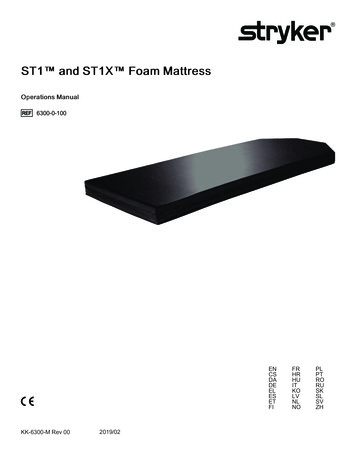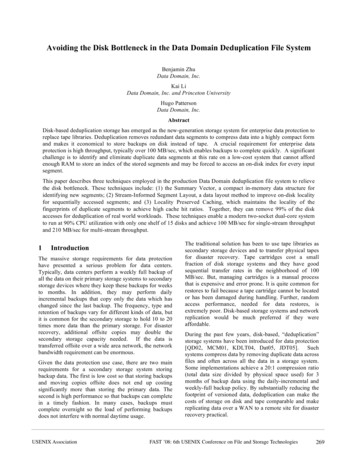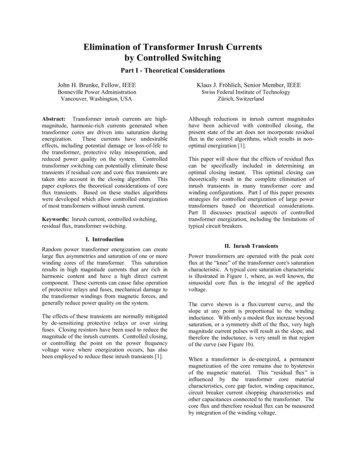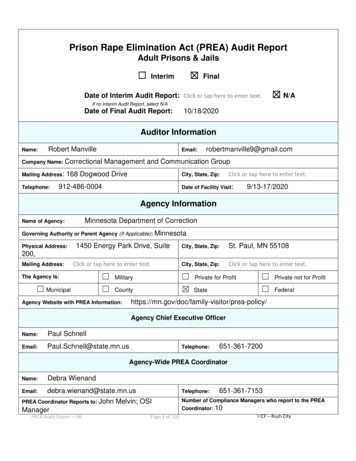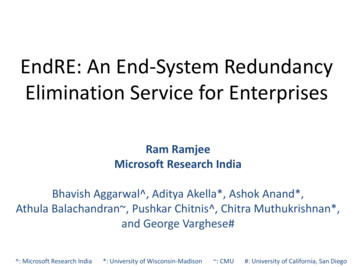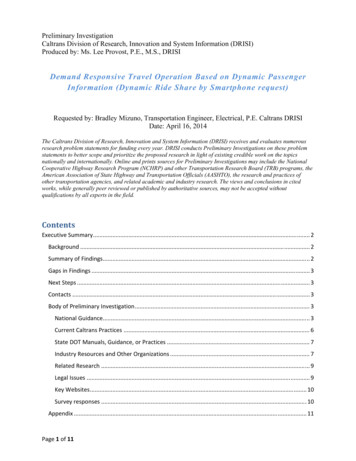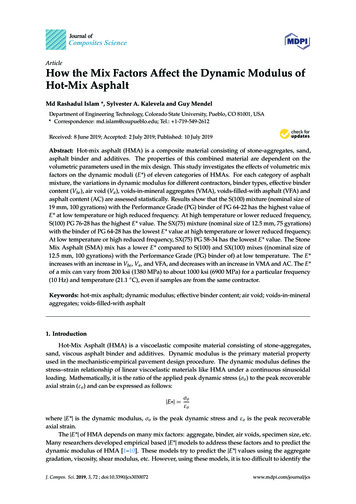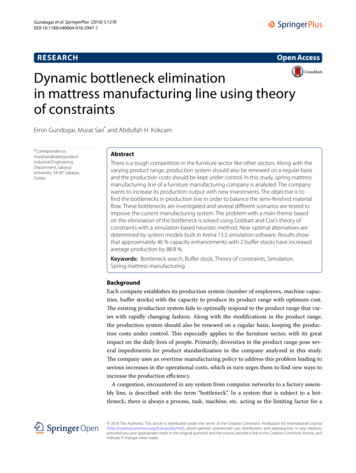
Transcription
Gundogar et al. SpringerPlus (2016) 5:1276DOI 10.1186/s40064-016-2947-1Open AccessRESEARCHDynamic bottleneck eliminationin mattress manufacturing line using theoryof constraintsEmin Gundogar, Murat Sari* and Abdullah H. strial EngineeringDepartment, SakaryaUniversity, 54187 Sakarya,TurkeyAbstractThere is a tough competition in the furniture sector like other sectors. Along with thevarying product range, production system should also be renewed on a regular basisand the production costs should be kept under control. In this study, spring mattressmanufacturing line of a furniture manufacturing company is analyzed. The companywants to increase its production output with new investments. The objective is tofind the bottlenecks in production line in order to balance the semi-finished materialflow. These bottlenecks are investigated and several different scenarios are tested toimprove the current manufacturing system. The problem with a main theme basedon the elimination of the bottleneck is solved using Goldratt and Cox’s theory ofconstraints with a simulation based heuristic method. Near optimal alternatives aredetermined by system models built in Arena 13.5 simulation software. Results showthat approximately 46 % capacity enhancements with 2 buffer stocks have increasedaverage production by 88.8 %.Keywords: Bottleneck search, Buffer stock, Theory of constraints, Simulation,Spring mattress manufacturingBackgroundEach company establishes its production system (number of employees, machine capacities, buffer stocks) with the capacity to produce its product range with optimum cost.The existing production system fails to optimally respond to the product range that varies with rapidly changing fashion. Along with the modifications in the product range,the production system should also be renewed on a regular basis, keeping the production costs under control. This especially applies to the furniture sector, with its greatimpact on the daily lives of people. Primarily, diversities in the product range pose several impediments for product standardization in the company analyzed in this study.The company uses an overtime manufacturing policy to address this problem leading toserious increases in the operational costs, which in turn urges them to find new ways toincrease the production efficiency.A congestion, encountered in any system from computer networks to a factory assembly line, is described with the term “bottleneck”. In a system that is subject to a bottleneck, there is always a process, task, machine, etc. acting as the limiting factor for a 2016 The Author(s). This article is distributed under the terms of the Creative Commons Attribution 4.0 International /), which permits unrestricted use, distribution, and reproduction in any medium,provided you give appropriate credit to the original author(s) and the source, provide a link to the Creative Commons license, andindicate if changes were made.
Gundogar et al. SpringerPlus (2016) 5:1276greater throughput, thus determining the capacity of the entire system. Knowing aboutthe bottleneck allows increasing the flow through improvement of a single process without having to intervene the whole system. In other words, the amendments made on anypoint other than the bottleneck, will not contribute to the output (Goldratt and Cox’s1984).Production lines involve various parameters such as processing times and setup times,which render keeping the balance of the line a serious challenge. As suggested by VanDelft et al. (2008) solution of such problems by means of mathematical modelling andsimilar deterministic methods in polynomial time is not possible due to their complexity and stochastic nature instead heuristic and approximate methods can be used forthis type of problems. Goldratt and Cox’s (1992) TOC is one of the heuristic methodswhich can be easily implemented to a simulation environment. Therefore, the problem,main theme of which is based on the elimination of the bottlenecks, is solved using TOCby means of a simulation based heuristic method. TOC has been used in various topicssuch as health care, finance, production, operations management, and quality management (Mabin and Balderstone 2003; Orouji 2016). There are several theoretical worksthat used TOC on operations management (Boyd and Gupta 2004; Gupta and Boyd2008), production process efficiency (Andelkovic et al. 2013), supply chain management(Puche et al. 2016).Bottleneck elimination process has four main steps which should be investigated thoroughly. These are material, machine and man (workforce), respectively (Üstün 2005).Bottleneck detection and elimination methods have been studied since the industrialrevolution, since detection of a bottleneck in a production system is a complex task.In the literature, there have been numerous studies about current bottleneck detectionmethods which can be divided into two categories as analytical and simulation-based (Liet al. 2007).Analytical methods yield satisfactory and reasonable results for long term analyses butthey are not suitable for short term analyses, since they can give misleading results inshort time intervals. There are several works including both fictive (Balbo and Serazzi1997; Amirghasemi and Zamani 2014) and experimental (Li et al. 2009) case studies, anddifferent analytical methods have been applied such as queuing theory (Lawrence andBuss 1995) and Markov chain theory (Chiang et al. 2001), for elimination of bottlenecks.Analytical approaches are not as sufficiently applicable as simulation based methodsfor real manufacturing processes due to highly complicated dynamic/stochastic structure of the problem. On the other hand, simulation based methods have some disadvantages such as the time required for modelling since different scenarios require differentmodels.Simulation based methods are widely used in many areas such as production policies(Al-Harkan and Hariga 2007), inventory model (Firoozi et al. 2013), scheduling (Baesleret al. 2015), maintenance (Razavi et al. 2015), assignment (Lam et al. 2014) problems andalso used in bottleneck elimination problems as following.Leporis and Králová (2010) applied several methods in simulation environment todetect bottlenecks in manufacturing processes and compared the advantages and constraints related to these methods. Scholz-Reiter et al. (2011) developed a systematic andcomprehensive definition of dynamic bottlenecks of the production networks based onPage 2 of 15
Gundogar et al. SpringerPlus (2016) 5:1276both the TOC and the bottleneck-oriented logistic analysis. Gopalakrishnan et al. (2014)investigated how a shifting priority strategy could be integrated into the schedulingof reactive maintenance. They applied the strategy in an automotive case-study, usingsimulation for decision support. They showed how to shift prioritization by tracking themomentary bottleneck of the system.On the other hand, in recent years, researchers have developed new hybrid methodsand techniques such as meta-heuristic algorithms with simulations (Volling and Spengler 2011).There are several studies (Sari et al. 2013; 2014a; b) similar to this one using onlycapacity increase to overcome bottleneck elimination problem.Simulation methods are widely applied to investigate and estimate bottleneck problems in a workflow. The aim of the current study is to improve the flow of products byreducing bottlenecks in production line using simulation tools. The company receivesorders from a wide range of dealers and directly transports the products to sub-vendors.In the current case, the company produces an average of 200 ( 5) products. The company aims to reduce the unit product costs as much as possible through maximization ofits daily output with required capacity enhancements. This is a case study to increase theproduction, based on factual data that have been acquired from a factory by modellingdiscrete event simulation (DES) of the production line.The rest of the study is organized as follows. Detailed analysis of the product and theproduction line is given in the second section. Work study and input analysis is given inthe third section. Definition, methodology, and application areas of the “theory of constraints” are explained in fourth section. Conceptual simulation model and applicationof package program is given in the fifth section. Verification and validation of the systemis given in sixth section. Finally, simulation results and conclusion are given in the seventh section.Manufacturing system descriptionA furniture company produces different spring mattresses. To understand the problemof interest, the materials used in a classical spring mattress are summarized in Table 1and shown in Fig. 1.Spring mattress manufacturing line consists of eight work stations, namely SpringKnitting, Gluing, Fabric Quilting, Overlock, Upholstering, Sewing, Quality control andTable 1 Descriptions of materials used in spring mattressMaterial name DescriptionFabricA woven cloth of organic or inorganic filamentsMattress frameMattresses are constructed by knitting spiral springs, which are made of high carbon reinforcedsteel fibre processed with heat treatmentBuckramA coarse cloth made of linen or hemp, stiffened with size or glue, which is used in garments tokeep them in the desired formFeltNonwoven fabric made by stratifying thin sheets of carded wool fibers, which is processedunder heat, moisture, and pressure to shrink and compress the fibers into a thick mattedcloth that will not ravel or fray. The felt uniformly distributes the weight on bed surfaceFoam rubberLight and spongy rubber which is used as a padding material in the mattressWaddingSoft fibrous cotton or wool material which is used for stuffing (wad) between fabric and mattress framePage 3 of 15
Gundogar et al. SpringerPlus (2016) 5:1276Fig. 1 The structure of classical spring mattressPackaging. The mattress manufacturing process starts in two different lines. Mattressframe is built in the Spring Knitting station at the first line. Then appropriately sized feltand foam rubber are glued up to that mattress frame in the gluing station. The secondbranch of manufacturing line consists of Fabric Quilting and Overlock stations. Fabric,buckram, wadding and foam rubber are sewn with appropriate designs (pattern) according to the features of mattress being produced. Afterwards, quilted fabric is overlockedif necessary. After the completion of processes in these two lines, semi-finished products(mattress frame and quilted fabrics) are combined in Upholstering station. Top and bottom quilted fabrics and lateral fabric (called bordure) are combined with straight binding process in the sewing station. In the quality control station, scrap suture strands areremoved from spring mattresses and physical examination test is carried out. Finally, thespring mattress is packaged automatically in the package station. Main steps of springmattress manufacturing process are summarized in Fig. 2.Work study and input analysisAs remarked by Law and Kelton (1991), a thorough and detailed modeling of a systemis time consuming and unnecessary in most cases. Indeed, as the number of the detailsincrease, verification and validation of the model becomes more difficult, increasing theerror risk. Therefore the details with no significant impact on the production system,are not included in the model. Twenty different types of mattresses are manufactured bythe company, each having seven different sizes. However, five most demanded types andsizes of mattresses are specified with ABC analysis (Reid and Sanders 2012) to be usedin the simulation. It should be noted that the impact of other demands is neglected. Pattern of demand is not require to change production within a day. Thus it is planned thatno batch change has been made during the day. Each type of selected mattress frame isFig. 2 Standard mattress manufacturing processPage 4 of 15
Gundogar et al. SpringerPlus (2016) 5:1276Page 5 of 15manufactured from a different type of bonnell spring. Other specifications of these mattresses are listed in Table 2.Production line flow is thoroughly observed and analyzed. Setup and process times ofall processes are determined using the time study and statistically evaluated using “Arenainput analyzer” software (Zupick et al. 2014).In this analysis, goodness of fit (Chi square) tests are applied. Mean square error ofthe tests is considered to be less than 5 %. Results of the time study and input analysiswere found too long to include in this paper so an example of these analyses are shownin Fig. 3.After the analyses, machine setup times, current capacities of stations and changeability of capacity are given in Table 3. The company management declared that the capacityof fabric quilting and packaging stations could not be modified, due to the high investment costs which are likely to add to the constraints already available in this problem.Also, the company can afford maximum two buffer stock areas.Company do not want to waste time with setup times as a production strategy. Inorder to do that they do not frequently change manufactured product. They start with aproduct and continue to produce till the order finishes. After that they set-up machinesand start to produce next product.In this scope, after the capacity enhancements completed buffer stock locations aredetermined, if required. Besides that determining the amount of buffer stocks are outTable 2 Specifications of micNoBJacquardErgonomicNoCNon-sweatUltra ergonomicYesDNon-sweatUltra ergonomicYesEJacquardStandardNoFig. 3 Time studySize (cm)90 19070 180150 200150 200150 200
Gundogar et al. SpringerPlus (2016) 5:1276Page 6 of 15Table 3 Machines’ specificationMachine codesMachine nameSetup times (min)aCurrent capacityModifiability
Packaging. The mattress manufacturing process starts in two different lines. Mattress frame is built in the Spring Knitting station at the first line. Then appropriately sized felt and foam rubber are glued up to that mattress frame in the gluing station. The second branch of manufacturing line consists of Fabric Quilting and Overlock stations .Cited by: 9Publish Year: 2016Author: Emin Gundogar, Murat Sari, Abdullah H. Kokcam
